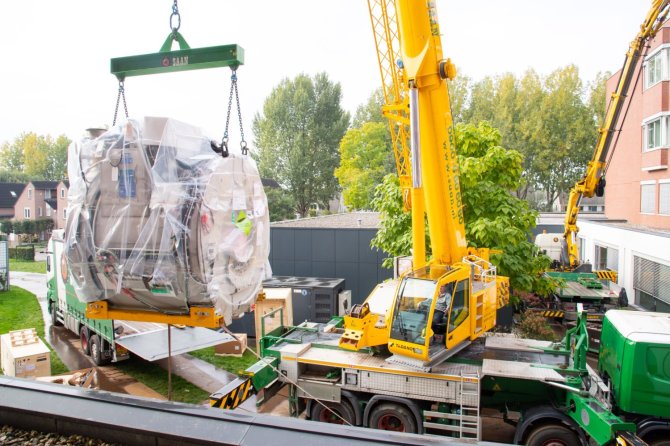
News
Cutting-edge MRI facility in Ede to benefit clinical and nutrition research
A major stride forward in the realisation of a state-of-the-art MRI facility in Ede was marked by the hoisting of a new MRI device into the hospital building on 17 October. Through this new facility, Wageningen University & Research (WUR) and Ziekenhuis Gelderse Vallei (Gelderse Vallei Hospital, ZGV) have created a unique environment for innovative nutrition research and high-quality diagnostics within the ZGV location. Gelderland Province and the Ministry of Economic Affairs and Climate Policy contributed to funding the MRI scanner.
The acquisition of the new 3 Tesla Magnetic Resonance Imaging (MRI) scanner follows up on the successful previous joint investment in the current 3T MRI facility. This facility was established at ZGV in 2011, as part of the Nutrition & Healthcare Alliance in which WUR and ZGV are collaborating partners. Replacing the current equipment is no simple matter; the device may be in place, but installation and training for this highly advanced piece of equipment will take a few weeks. The facility is expected to be available for use in research for knowledge institutes and businesses as of December.
Nutrition research
MRI-techniques have significantly improved in recent years. “This model offers additional possibilities for innovative nutrition research”, says Paul Smeets, project leader at the Human Nutrition and Health department at WUR. This is seen as a considerable update. The new MRI can produce images faster, with a higher resolution, and with a wider variety of options.
We will be able to focus on specific processes, such as the digestion of proteins in the stomach
“This offers us new opportunities in our research on the effect of food on the brain, body composition (fat and muscle ratio) and digestion”, Smeets says. “The MRI can follow the ‘behaviour’ of foodstuffs in the stomach. We will be able to focus on specific processes, such as the digestion of proteins in the stomach. The expertise generated through our research can be applied by businesses toward developing innovative food products. In this way, we can jointly make an important contribution to tackling societal challenges such as obesity.”

Clinical research and diagnostics
In close collaboration with the Human Nutrition and Health department, ZGV studies smell and taste disorders through the Reuk & Smaakcentrum (Smell & Taste Centre), an initiative of the Nutrition & Healthcare Alliance. The MRI allows for a better prediction of the progression of the disease and of the effectiveness of treatments such as smell training. ZGV will also apply the new MRI in prostate exams and studies on (elite) sports-related injuries through Sports Valley.
We will be able to identify very small ruptures in muscle tissue in sports-related injuries
Gerlinda Reijnoudt, ZGV Radiology department manager, stresses that the stronger magnetic field of the new MRI provides significant advantages over the two 1.5 Tesla MRI devices the ZGV already possesses. “This stronger signal allows us to see more detail. Thus, we will be able to identify very small ruptures in muscle tissue in sports-related injuries and provide more dependable diagnoses in prostate exams. Moreover, the device is faster, which is a huge advantage for the patient and us. The new options of the 3 Tesla MRI allow us to optimise existing methods further and to develop new research techniques.”
Shared facility
The new 3T MRI is acquired by WUR’s Shared Research Facilities, with financial support from Gelderland province and the Ministry of Economic Affairs and Climate Policy. Thanks to the collaboration with ZGV, a unique facility has been created that is also available for use by researchers from other universities, hospitals and businesses. For example, through collaboration with WUR or ZGV, but also independently with support from these organisations. “We offer tailor-made solutions for different users so that they can perform research themselves or have studies done for them. This ranges from setting up the equipment and providing skilled operators to data-analysis and interpretation of the images”, Smeets explains.
The investment in the new MRI is in line with the ambition to make advanced equipment and facilities available for shared use in the Foodvalley innovation ecosystem. To this end, Shared Research Facilities collaborates closely with Foodvalley Facilities (Foodvalley NL) within the Foodvalley 2030 programme.